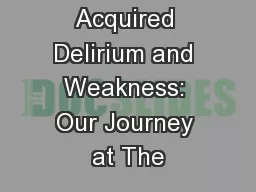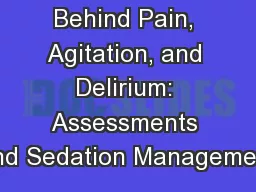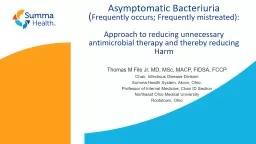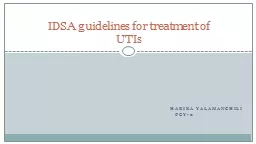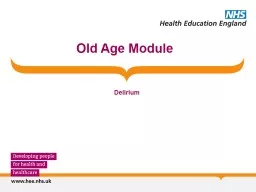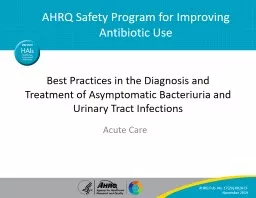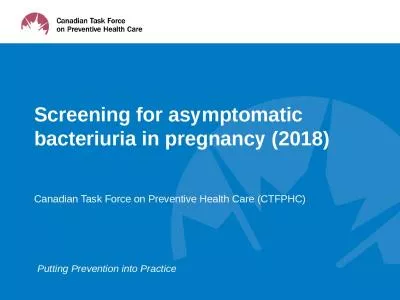PPT-Asymptomatic bacteriuria, Antibiotics and Delirium:
Author : ellena-manuel | Published Date : 2020-04-03
Project Presentation Kate McCollough Jennifer Dulin FuNdAmentals of Epidemiology I December 3 2019 Study Question Question Does antibiotic treatment of ASB decrease
Presentation Embed Code
Download Presentation
Download Presentation The PPT/PDF document " Asymptomatic bacteriuria, Antibiotics a..." is the property of its rightful owner. Permission is granted to download and print the materials on this website for personal, non-commercial use only, and to display it on your personal computer provided you do not modify the materials and that you retain all copyright notices contained in the materials. By downloading content from our website, you accept the terms of this agreement.
Asymptomatic bacteriuria, Antibiotics and Delirium:: Transcript
Project Presentation Kate McCollough Jennifer Dulin FuNdAmentals of Epidemiology I December 3 2019 Study Question Question Does antibiotic treatment of ASB decrease the incidence of discharge to a facility for hospitalized patients aged 70 or older admitted from home with a positive delirium screen . Practical strategies for . acute treatment and prevention of recurrent UTIs in the elderly. Ailsa Wilson Edwards. Continence Matters. CONTINENCE MATTERS. UTIs in elderly. The problem. Common. Most frequent infection in residential care. Rose Buckingham MSN. Kelly Goetschkes MSN. Objectives. Describe what delirium is and common . risk factors. Identify common symptoms, and implications of delirium for the hospitalized adult. Summarize TNMC ICU Outcomes Study results and what we learned going forward. CDC’s Antimicrobial Resistance Laboratory Network in Nevada. Julia (Julie) A. Kiehlbauch, Ph.D., D(ABMM). Objectives. At the completion of the presentation, attendees will be able to:. Compare and contrast bacteremia, sepsis and asymptomatic bacteremia. National Content Series for All Staff. Current as of October 2015. Upon completion of this training, participants will be able to. :. Explain why unnecessary urine cultures can lead to increases in CAUTI reporting and resident harms. Amy Robertson, . PharmD. PGY-1 Pharmacy Resident – UAMS NW. Disclosure and Conflict of Interest. I have no . relevant financial or nonfinancial relationships . or conflicts of interest to . disclose.. AHRQ Safety Program for . Mechanically Ventilated Patients. AHRQ Pub. No. 16(17)-0018-43-EF. January 2017. Learning Objectives. After . this session, you will be able . to—. Identify the objectives and benefits of using the . Chair, Infectious Disease Division. Summa Health System, Akron, Ohio;. Professor of Internal Medicine, Chair ID Section. Northeast Ohio Medical University. Rootstown, Ohio. Asymptomatic Bacteriuria . IDSA guidelines for treatment of UTIs. IDSA: Infectious . Diseases Society of . America. Definitions. Acute . cystitis: infection . of the . bladder - lower . urinary . tract. Pyelonephritis: infection . The . overall aim of the session is for the trainee to gain an overview of delirium. By . the end of the sessions the trainee should:. Understand . the epidemiology, the risk factors associated and the basic physiological and psychological changes associated with delirium. Date of Training. Agenda . Welcome. How Can Viruses Spread From Someone Who Doesn’t . Feel Sick?. Reflection. Asymptomatic Spread of COVID-19. 2. Learning Objectives . Explain how a person can be infected with SARS-CoV-2 and not feel sick but can . Acute . Care. AHRQ Safety Program for Improving Antibiotic . Use. AHRQ Pub. No. 17(20)-0028-EF. November 2019 . Objectives. Explain how to distinguish asymptomatic bacteriuria from a urinary tract infection (UTI. These are the . most common . bacterial infections during pregnancy.. :. Its prevalence is. (. 5-6 %. ). asymptomatic . bacteriuria. . 1 - 2 %) . ). cystitis. (. 0.5 - 2 %. ). Pyelonephritis. Microbiology. Dr.Esraa. AL-. Maini. Asymptomatic . bacteriuria. (. ASB. )during pregnancy. Asymptomatic . bacteriuria. (. ASB. ) is defined as persistent bacterial . colonisation. of the urinary tract without urinary tract symptoms.. 2018). Canadian Task Force on Preventive Health Care (CTFPHC). Use of Slide Deck . These slides are made . available publicly . following the guideline’s release as an educational support to assist with the dissemination, uptake and implementation of the guidelines into primary care practice .
Download Document
Here is the link to download the presentation.
" Asymptomatic bacteriuria, Antibiotics and Delirium:"The content belongs to its owner. You may download and print it for personal use, without modification, and keep all copyright notices. By downloading, you agree to these terms.
Related Documents


